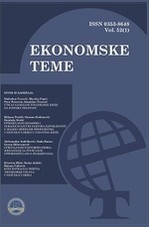Economic Themes (2024) 62 (1) 1, 1-17
Predrag Grozdanović, Miloš Nikolić, Milica Šelmić, Dragana Macura
Abstract: As the backbone of environmentally sustainable transport, rail transport is one of the most preferred modes since it emits three times less CO2 and particulates per ton-mile than road transport. Besides these ecological benefits, rail transport is the most cost-effective. The global energy crisis creates significant problems and challenges for rail companies when planning transportation activity costs. Companies must carefully consider energy spending and ways to decrease it. In this paper, the authors considered the problem of predicting freight train energy consumption to help companies plan their budgets. For that purpose, the authors applied three time series methods: the moving average, the weighted moving average, and the exponential smoothing method. These methods were applied to actual data collected in the Republic of Serbia. The results showed that the exponential smoothing method performs better than the other two approaches. Nevertheless, there is still room for improvement in the presented approaches, such as fine-tuning the parameters used and comparing them to other relevant techniques used for the forecast.
Keywords: Freight train; energy consumption; time series models; forecast
PREDICTION OF THE FREIGHT TRAIN ENERGY CONSUMPTION WITH THE TIME SERIES MODELS
Predrag Grozdanović, Miloš Nikolić, Milica Šelmić, Dragana Macura
Abstract: As the backbone of environmentally sustainable transport, rail transport is one of the most preferred modes since it emits three times less CO2 and particulates per ton-mile than road transport. Besides these ecological benefits, rail transport is the most cost-effective. The global energy crisis creates significant problems and challenges for rail companies when planning transportation activity costs. Companies must carefully consider energy spending and ways to decrease it. In this paper, the authors considered the problem of predicting freight train energy consumption to help companies plan their budgets. For that purpose, the authors applied three time series methods: the moving average, the weighted moving average, and the exponential smoothing method. These methods were applied to actual data collected in the Republic of Serbia. The results showed that the exponential smoothing method performs better than the other two approaches. Nevertheless, there is still room for improvement in the presented approaches, such as fine-tuning the parameters used and comparing them to other relevant techniques used for the forecast.
Keywords: Freight train; energy consumption; time series models; forecast

